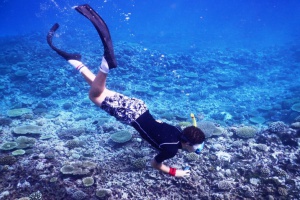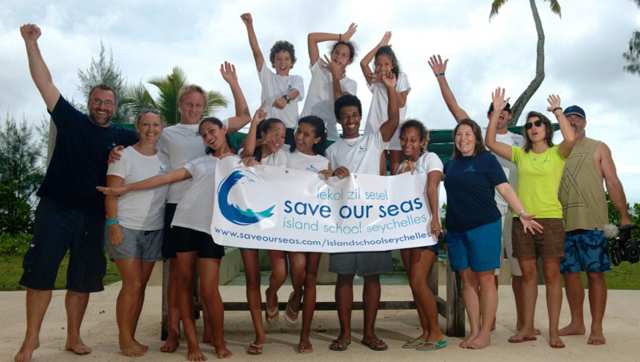Budding eco-warriors discover Seychelles’ D’Arros island with Save Our Seas Foundation
Conservation |Author: Hajira Amla and Abi March | May 20, 2014, Tuesday @ 15:46| 42926 views
Noah Jean-Louis snorkels over the reef at DArros (Save our Seas Foundation)
(Seychelles News Agency) - One might only dream of being whisked away to a tropical island for two weeks, exploring coral reefs and seeing turtles nesting in the sand. But for sixteen Seychellois schoolchildren aged between 12 and 17, this was a reality.
For two idyllic weeks they escaped from school to visit the coralline outer island of D’Arros, which is part of the Seychelles’ Amirantes group of islands lying 230km distant from Mahé.
The young adventurers, known as the D’Arros Exploraters, who are members of the Save Our Seas Foundation "Lekol Zil Sesel" (SOSF Island School Seychelles) were taking part in the D’Arros Experience at the SOSF D’Arros Research Centre to learn about the unique ecosystems of D’Arros and the neighbouring St Joseph Atoll.
Named after Baron d'Arros, who was a French Marine Commandant stationed in Mauritius in the late 1700s, the island of D’Arros was since 1975 privately owned, first by an Iranian prince, Shahram Pahlavi Nia, and then by French billionaire Liliane Bettencourt, until it was re-sold in 2012 and given over to the Save Our Seas Foundation for marine conservation projects.
SOSF has funded and supported research, education and conservation projects worldwide over the past ten years. Although it is not a research institute, SOSF’s contributions have already facilitated over 160 marine research and conservation projects around the world.
The D’Arros Experience project, which is coordinated annually by both SOSF and the Seychelles Ministries of Environment and Education, was designed to expose young Seychellois adults to an environmental system that would inspire them to become active ambassadors and custodians of the seas that surround them and are intricately connected to every aspect of their lives as islanders.
The children spent time in each unique part of the D’Arros and St Joseph system, including the atoll lagoon, mangrove channels, tropical broad-leaf forests, nesting turtle habitats and coral reefs teeming with life.
“The foundation regards environmental education as an invaluable investment in our planet’s future. Programmes like the D’Arros Experience that provide us with a unique opportunity to give young people direct exposure to the natural world outside of the classroom are one of the most valuable tools that we have as conservationists,” said SOSF Chief Executive, Michael Scholl.
|
|
| Some of the staff and students of the DArros Experience (Save our Seas Foundation) Photo License: Attribution |
As part of the programme, the students were encouraged to write blog posts on the D’Arros Experience blog site about their discoveries, with some surprisingly profound pieces of writing.
Laura Montano, 16, was distressed to find how much litter carried on the currents from far-away inhabited islands and sea vessels could wash up in a place like D’Arros.
“My friends and I were very surprised by the immense amount of litter we found. There were loads of plastic bottles, polystyrene and slippers. The visual pollution was bad, but what really touched me was realising how litter from miles away could affect an innocent habitat like D’Arros,” she wrote.
“I think there was so much litter because people are very negligent. It really gets on my nerves that we are so self-centered that we couldn’t care less about the animals choking on the plastic bags, or the ones dying from poisoning. I also understand though, that some people just don’t know about the negative effects littering can have on the environment.”
14-year-old Tessa Mancienne was snorkelling with her group when all of a sudden, an unexpected visitor gave her quite a shock.
“…I spied something that sent a shudder of fear running down my spine and caused me to freeze. A black-tip reef shark had joined our snorkel. I was quite puzzled when it swam away without a care in the world. I had always thought sharks were quite aggressive. Another came in shortly after. This one seemed smaller in size,” wrote Tessa.
“I grabbed every opportunity to study and be mesmerized by the beauty of a healthy marine ecosystem. We looked at the diversity of fishes and corals and invertebrates. I looked ahead in amazement when all of a sudden a small, friendly green turtle came to greet us. My heart filled with joy when I saw the turtle swimming in its natural habitat, being free in the wild. It was amazing to watch. Slowly but smoothly it left us alone and continued its journey towards the open ocean.”
Carol Hoareau, 16, had an emotional encounter with a nesting green turtle. “It was the first time I had witnessed such a special event,” she wrote. “Every single thing that I had learned about turtles this week came to life right in front of me. Experiencing it for myself was really inspiring.
“It felt amazing standing so close to such an animal that I had only learned about in the classroom. Hearing it breathe and move through the sand brought this feeling of joy and admiration. My respect for this animal definitely deepened. I knew turtles were important, but seeing one up close on land created this sense of urgency: it is truly my duty as a member of the growing generation to do something for their well-being and protect this species from the threats it faces.”
Back

